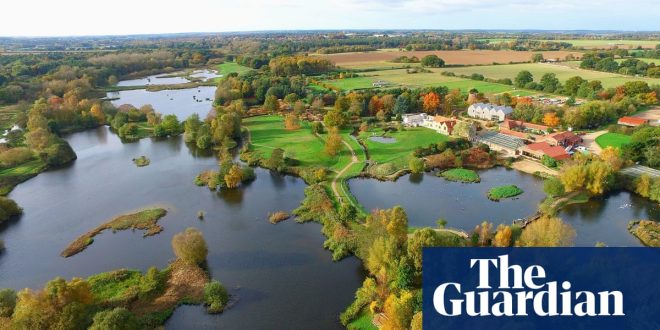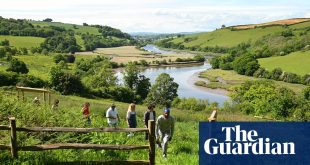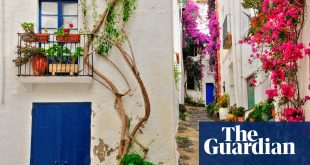It’s 5am and I awake to the sound of a gaggle of greylag geese heralding the morning outside my bell tent. The dawn chorus is in full swing, and shortly after I get up to enjoy it, I come face to face with a wild hare and spot a muntjac deer flashing past the boundary of the campsite.
To the extreme envy of all my nature-loving friends, I am one of the first glampers to stay at the brand new campsite which recently opened in Pensthorpe natural park, an internationally renowned nature reserve near Fakenham in north Norfolk.
About 170 species of bird have been recorded at the 280-hectare (700-acre) site as well as otters, hedgehogs, bats, deer, badgers, voles, stoats, harvest mice, brown hare, trout, eels and bullhead fish, plus an array of dragonflies, moths and butterflies.
This summer, for the first time ever, visitors can stay overnight at the reserve, in a field set up for 24 grass tent pitches and six glamping bell tents festooned with bunting. Sitting outside one of these in my deckchair, listening to a chiffchaff cheerfully greeting the new day by calling out its name, I suddenly realise: I am the only person awake in one of the most biodiverse nature reserves in England.
It sends a little tingle down my spine. The park, which is equivalent in size to more than 400 football pitches, was created 40 years ago by the millionaire conservationist Bill Makins, who extracted a million tonnes of gravel from the site and then turned the former gravel pits into huge, landscaped lakes and ponds. Most are fed by the river Wensum, which runs through the reserve; as one of only 200 chalk streams in the world, the Wensum is a highly protected Site of Special Scientific Interest, providing the reserve’s wild and endangered waterfowl with naturally clean water from underground chalk aquifers and springs.
Hours later, after my husband and our 12-year-old daughter Flora have woken up and we’ve had a breakfast roll at the reserve cafe, we leave the fenced-in field of the campsite behind and formally enter the wilderness of the reserve for the first time.
Our first stop is a wader aviary where, underneath a huge net, avocets, corncrakes, bearded tits and their young are free to roam about next to us. I have never been anywhere like it. “These are all birds we generally have nesting on the reserve, but you’d never get this close to their nests in the wild,” says David Roberts, a senior reserve warden, who is taking us on a guided tour.
In total, there are five gardens in the park. First, we walk through the wildlife habitat garden – designed to offer gardeners ideas about how they can support pollinators and wildlife at home – and out into the wave garden, a sculpture-filled woodland garden made up of cultivated varieties of wild plants. The entrance into the untamed landscape of the actual reserve is seamless, like a secret portal into another world. “You don’t notice you’re coming out of a garden, it just blends in,” says Roberts.
He spots a great crested grebe on one of the lakes and points out a couple of diving ducks and some Egyptian geese before we pop into a bird hide, where a swallow has made its nest in the rafters. It darts in constantly to feed its hungry chicks, delighting Flora, who can’t stop taking photographs.
We pass a wildflower meadow brimming with ragwort, lady’s bedstraw and knapweed, and cross a bridge where yellow reeds ripple under the water like the blond tresses of a mermaid. At one point, Flora rescues a baby toad from the path, persuading it to hop on to her hand and then into the river reeds. Butterflies occasionally flutter past – Roberts knows all their names and seems to have an encyclopedic knowledge of birds and insects. That evening he will set a moth trap and observe species including a gorgeous red elephant hawk-moth (which settles for five magical minutes on Flora’s finger) and a couple of astonishing buff-tips, which look exactly like silver birch twigs.
Such rich diversity of insects ensures the reserve is a paradise for bats, and that evening we join other campers and visitors for a special walk to capture nocturnal recordings of its sopranos, brown long-eared bats and common pipistrelles. We also search for animal and bird tracks and set camera traps for passing wildlife.
Afterwards, we sit around the fire pit outside our tent, cooking dinner, toasting marshmallows and playing card games. There are flushable, solar-powered toilets and showers on the site, and the accommodation in our bell tent comprises a double bed and three single beds, a bedside table, fairy lights, a thick rug and a power pack, where we can plug in a lamp or charge our phones.
By 10.30pm I am fast asleep – only to be woken, a few hours later, by the piercing call of an incredibly loud bird. I later learn it belongs to one of the eight vociferous cranes that live on the reserve – Pensthorpe’s charitable conservation arm spearheaded a programme to breed and release these rare birds, which were extinct in England for 400 years.
After a cooked breakfast in the cafe the next morning, we head back into the reserve to sneak a peek at 67 flamingos and their chicks, as well as the cranes who woke me up. The east African grey crowned cranes are the most ostentatious, with their bright feathery headdresses, while the native common cranes seem more elegant and refined.
We feed ducks, geese and moorhens with bird feed from the shop, then head to the adventure playground (included in the price of entry) to play on a zip wire and swing halfway to the clouds on a rope swing.
After lunch, there is just enough time, before we have to leave, to nip back into the reserve for a final off-road vehicle tour. On a hill in the vast wildflower meadow, Flora and I spot a roe deer almost entirely camouflaged by thick purple thistles and white yarrow, watching us intently. This place is a wild place, she seems to be saying; it is wild and it is mine and it is precious. Then she darts away into the flowers and disappears, leaving nothing but her powerful message behind.
The trip was provided by Visit Norwich and Pensthorpe natural park. A two-night glamping stay in a five-bed tent costs between £240 and £290, including two days’ entry into the reserve. Tent pitches £30-35 a night, including two days’ entry into the park for an extra £16.95pp, a 50% discount on day rates. The campsite is open until the end of August
 Top Naija News – Nigeria News, Nigerian News & Top Stories Top Naija News – Nigerian Newspapers, Nigerian News. topnaijanews is a daily Nigerian newspaper covering Latest News, Breaking News, Entertainment, Sports, Lifestyle and Politics.
Top Naija News – Nigeria News, Nigerian News & Top Stories Top Naija News – Nigerian Newspapers, Nigerian News. topnaijanews is a daily Nigerian newspaper covering Latest News, Breaking News, Entertainment, Sports, Lifestyle and Politics.




